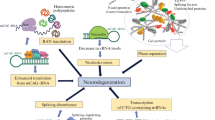Abstract
An increasing number of inherited neurodegenerative diseases are known to be caused by trinucleotide repeat expansions in the respective genes. At least nine disorders result from a CAG trinucleotide repeat expansion which is translated into a polyglutamine stretch in the respective proteins: Huntington's disease (HD), dentatorubral pallidolysian atrophy (DRPLA), spinal bulbar muscular atrophy (SBMA), and several of the spinocerebellar ataxias (SCA1, 2, 3, 6, 7 and 12). Although the molecular steps leading to the specific neuropathology of each disease are unknown and are still under intensive investigation, there is increasing evidence that some CAG repeat disorders involve the induction of apoptotic mechanisms. This review summarizes the clinical and genetic features of each CAG repeat disorder and focuses on the common mechanistic steps involved in the disease progression of these so-called polyglutamine diseases. Among the common molecular features the formation of intranuclear inclusions, the recruitment of interacting polyglutamine-containing proteins, the involvement of the proteasome and molecular chaperones, and the activation of caspases are discussed with regard to their potential implication for the induction of cell death.
Similar content being viewed by others
Author information
Authors and Affiliations
Additional information
Electronic Publication
Rights and permissions
About this article
Cite this article
Evert, B., Wüllner, U. & Klockgether, T. Cell death in polyglutamine diseases. Cell Tissue Res 301, 189–204 (2000). https://doi.org/10.1007/s004410000228
Received:
Accepted:
Published:
Issue Date:
DOI: https://doi.org/10.1007/s004410000228




